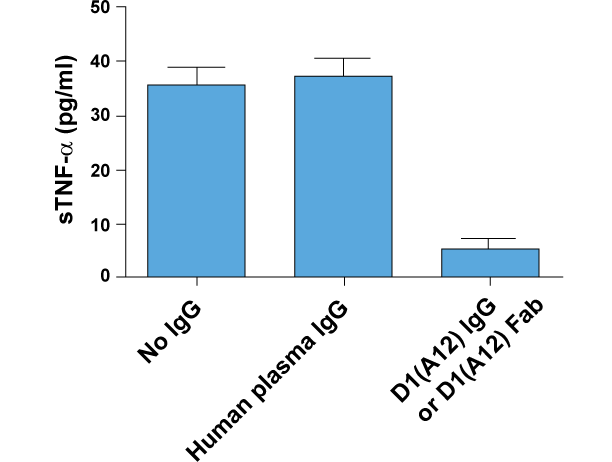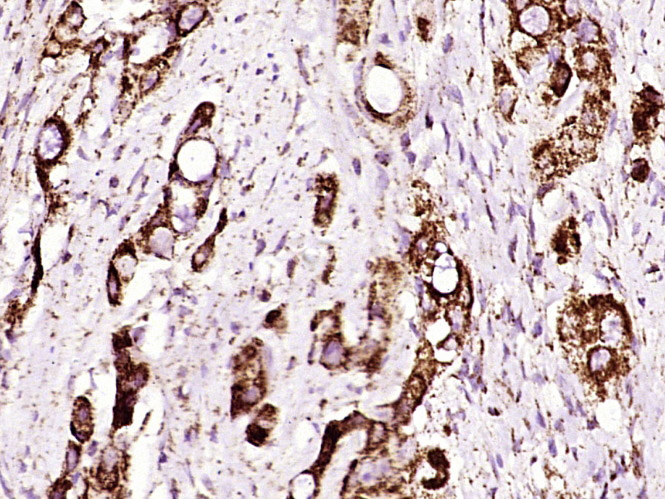
D1(A12) IgG or D1(A12) Fab inhibits constitutive shedding of TNF-alpha from IGROV1 (human ovarian cancer cell line) into culture medium. Medium was collected after 48 hours of incubation with or without IgGs at 200nM.
anti-ADAM17 (human), mAb (rec.) (blocking) (D1(A12)) (Fab Fragment) (His)
AG-27B-6003PF
ApplicationsFunctional Assay, Neutralisation/Blocking
Product group Antibodies
ReactivityHuman
TargetADAM17
Overview
- SupplierAdipoGen Life Sciences
- Product Nameanti-ADAM17 (human), mAb (rec.) (blocking) (D1(A12)) (Fab Fragment) (His)
- Delivery Days Customer10
- ApplicationsFunctional Assay, Neutralisation/Blocking
- CertificationResearch Use Only
- ClonalityMonoclonal
- Clone IDD1(A12)
- Concentration1 mg/ml
- Estimated Purity>95%
- Gene ID6868
- Target nameADAM17
- Target descriptionADAM metallopeptidase domain 17
- Target synonymsADAM18, CD156B, CSVP, NISBD, NISBD1, TACE, disintegrin and metalloproteinase domain-containing protein 17, ADAM metallopeptidase domain 18, TNF-alpha convertase, TNF-alpha convertase enzyme, TNF-alpha converting enzyme, a disintegrin and metalloproteinase 17, cartilage snake venom-like protease, snake venom-like protease, tumor necrosis factor, alpha, converting enzyme
- HostHuman
- Protein IDP78536
- Protein NameDisintegrin and metalloproteinase domain-containing protein 17
- Scientific DescriptionADAM17 (Disintegrin and metalloproteinase domain-containing protein 17), also called TACE (Tumor necrosis factor-alpha-converting enzyme) is the prototype of the ADAM family of ectodomain shedding proteases (sheddase). ADAM17 is understood to be involved in the processing of TNF-alpha at the surface of the cell and from within the intracellular membranes of the trans-Golgi network. This process involves the cleavage and release of a soluble ectodomain from membrane-bound pro-proteins (such as pro-TNF-alpha) and is of known physiological importance. ADAM17 is responsible for the processing of a diverse variety of membrane-anchored cytokines, cell adhesion molecules, receptors, ligands and enzymes, including cleaving epidermal growth factor receptor (EGFR) ligands and extracellular Notch1. The proteolytic cleavage is an indispensable activation event for many of these substrates, ADAM17 has emerged as an attractive therapeutic target for the treatment of inflammatory diseases (e.g. rheumatoid arthritis) or inflammation associated cancer. - Recombinant Antibody. Recognizes the catalytic and non-catalytic domain of human ADAM17 (TACE) through its variable light (VL) domain and variable heavy (VH) domain, respectively. Does not bind recombinant mouse ADAM17 ectodomain. Species cross-reactivity: Human. Clone: D1(A12). Isotype: Human Fab fragment, kappa, His-tagged. Applications: FUNC, FUNC (Blocking). Host: E. coli. Liquid. In PBS. ADAM17 (Disintegrin and metalloproteinase domain-containing protein 17), also called TACE (Tumor necrosis factor-alpha-converting enzyme) is the prototype of the ADAM family of ectodomain shedding proteases (sheddase). ADAM17 is understood to be involved in the processing of TNF-alpha at the surface of the cell and from within the intracellular membranes of the trans-Golgi network. This process involves the cleavage and release of a soluble ectodomain from membrane-bound pro-proteins (such as pro-TNF-alpha) and is of known physiological importance. ADAM17 is responsible for the processing of a diverse variety of membrane-anchored cytokines, cell adhesion molecules, receptors, ligands and enzymes, including cleaving epidermal growth factor receptor (EGFR) ligands and extracellular Notch1. The proteolytic cleavage is an indispensable activation event for many of these substrates, ADAM17 has emerged as an attractive therapeutic target for the treatment of inflammatory diseases (e.g. rheumatoid arthritis) or inflammation associated cancer.
- ReactivityHuman
- Storage Instruction-20°C,2°C to 8°C
- UNSPSC12352203





